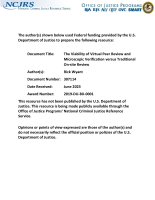Law enforcement
Beyond impunity: An evaluation of New York State's nonfatal shooting initiative
Perceptions of Officer Roles in School Resource Officer Programs
Classifying Crime Places by Neighborhood Visual Appearance and Police Geonarratives: A Machine Learning Approach
Detection of JPEG double compression and identification of smartphone image source and post-capture manipulation
Un-served Arrest Warrants: An Exploratory Study
Multiple Imputation for Missing Values in Homicide Incident Data: An Evaluation Using Unique Test Data
Integrating Population Health Data on Violence Into the Emergency Department: A Feasibility and Implementation Study
Police Use Science and Community Partnerships to Reduce Gun Violence
Estimating Age of Death from Subadult Remains, Part 1
The long-standing problem of estimating the age and sex of subadult skeletal remains has been significantly "solved" with the advances in understanding the growth and development patterns in the skeletons of young people. Kyra Stull, an anthropologist and forensic researcher at University of Nevada, Reno, and Danielle McLeod-Henning, a physical scientist at NIJ, share more about this research with NIJ writer and host Jim Dawson.





